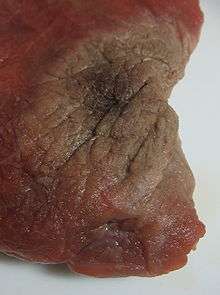Freezer burn

Freezer burn is a condition that occurs when frozen food has been damaged by dehydration and oxidation, due to air reaching the food.[1] It is generally caused by food not being securely wrapped in air-tight packaging.
Freezer burn appears as grayish-brown leathery spots on frozen food, and occurs when air reaches the food's surface and dries the product. Color changes result from chemical changes in the food's pigment. Freezer burn does not make the food unsafe; it merely causes dry spots in foods.[2] Provided that the freezer burns are removed before cooking, the food remains usable and edible.
Cause and effects
The condition is primarily caused by sublimation. Water evaporates at all temperatures, even from the surface of solid ice. If air adjacent to ice is cold enough and the air is dry enough, the ice does not melt and water molecules go directly from solid phase (ice) to gaseous phase (vapor) without going through a liquid phase. When the constantly vibrating water molecules in foods stored in a freezer migrate to the surface, crystals of ice outside of the solid food are formed, and some water molecules escape into the air by sublimation. The parts of meat which are deprived of moisture become dry and shrivelled, appearing "burnt". In meats, air can cause fats to oxidize.
This process occurs even if the package has never been opened, due to the tendency for all molecules, especially water, to escape solids via vapour pressure. Fluctuations in temperature within a freezer also contribute to the onset of freezer burn because such fluctuations set up temperature gradients within the solid food and air in the freezer, which create additional impetus for water molecules to move from their original positions.
It is possible to slow freezer burn by filling plastic containers with water and leaving them open (leaving room for expansion) in the freezer to help maintain humidity. Proper packaging can also help delay freezer burn because small, air-tight packaging allows local homeostasis of humidity, and, to a lesser degree, temperature, although current available packaging cannot do this perfectly.
Meats and vegetables stored in a manual-defrost freezer will last longer than those stored in automatic-defrost freezers. This is because the temperature of a manual defrost freezer remains closer to −18 °C (0 °F) while the temperature of automatic defrost freezers fluctuates, and because automatic-defrost freezers have drier air, thus the rate of sublimation increases.
Food with freezer burn, though dried and wrinkled, is safe to eat. However, food afflicted with freezer burn may have an unpleasant flavour. In most cases, it is sufficient to remove the parts affected by freezer burn.
See also
References
Inline citations
- ↑ Library of Congress. "What is 'freezer burn?'". Everyday Mysteries: Fun Science Facts from the Library of Congress.
- ↑ "Does 'freezer burn' make food unsafe?". USFDA. Archived from the original on June 17, 2008.
